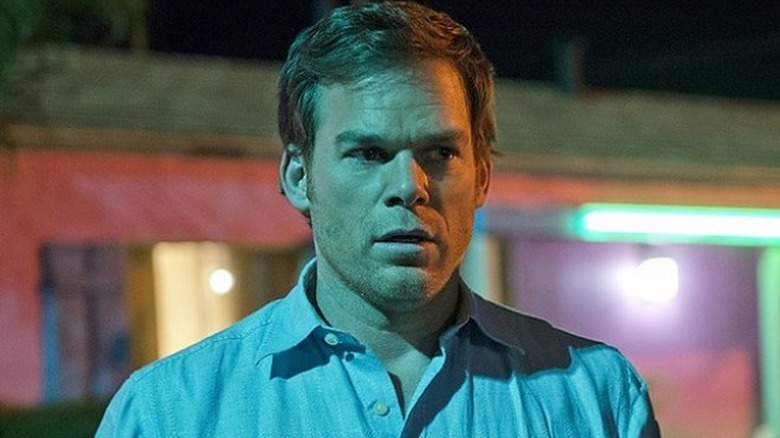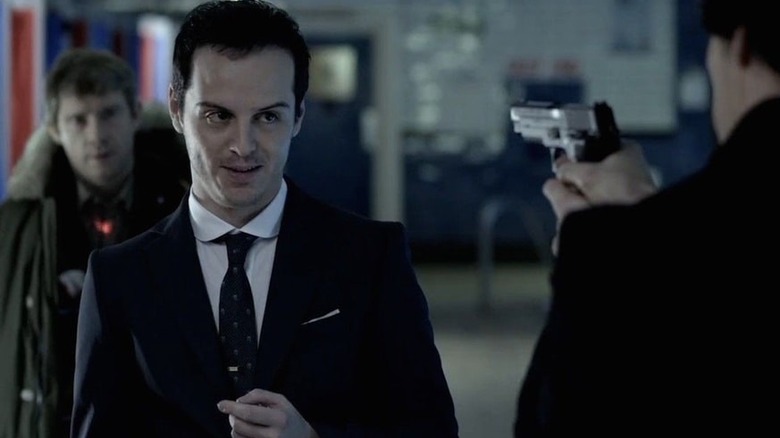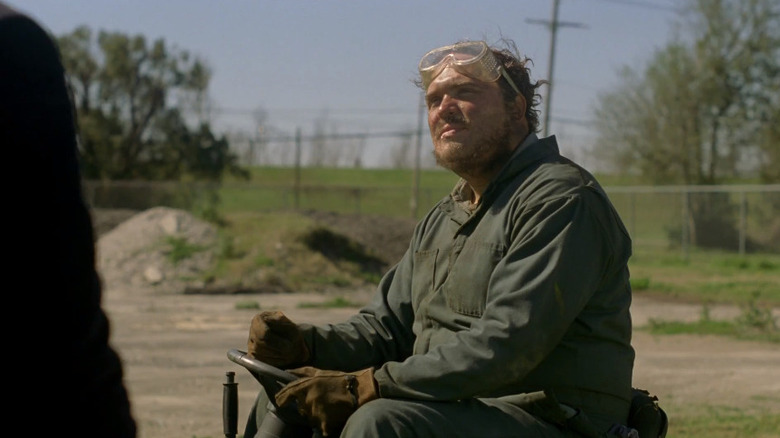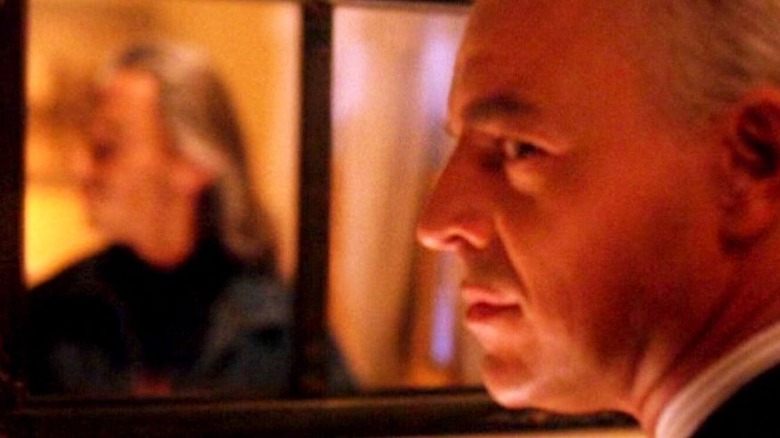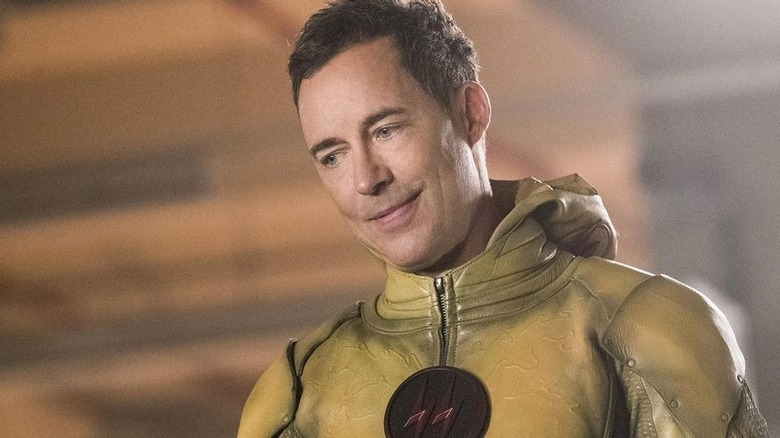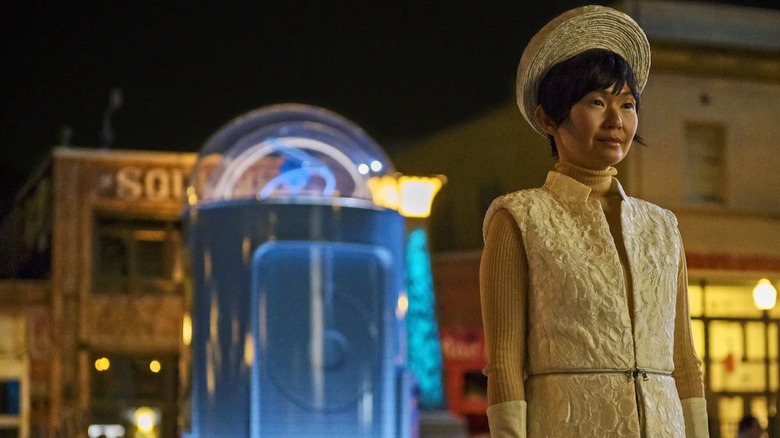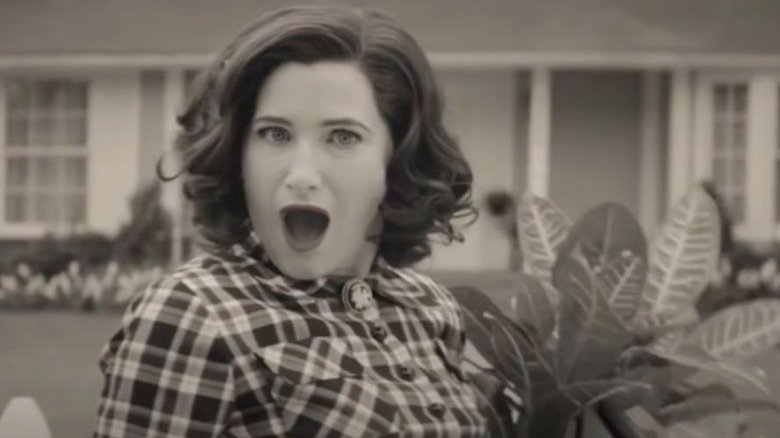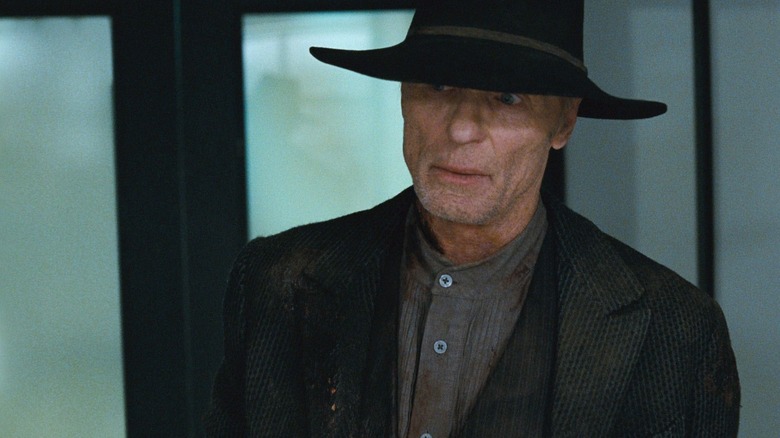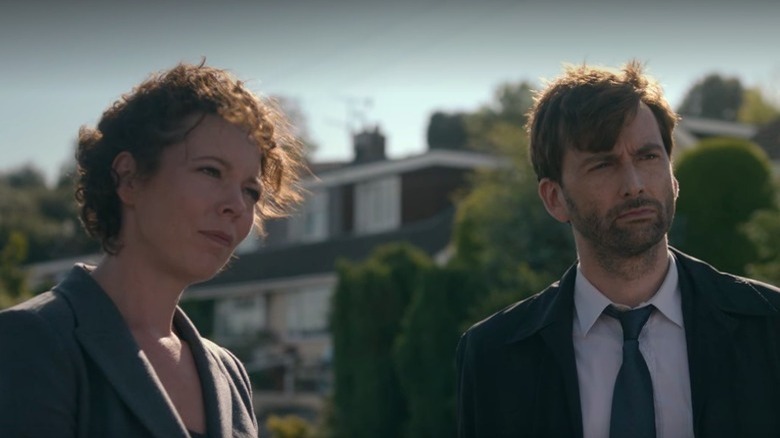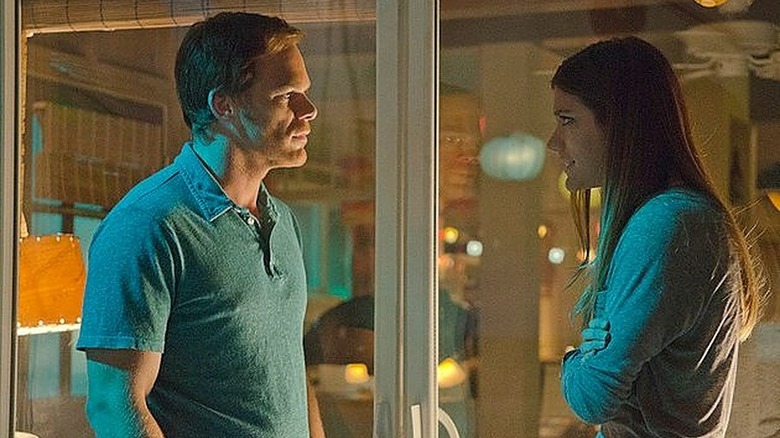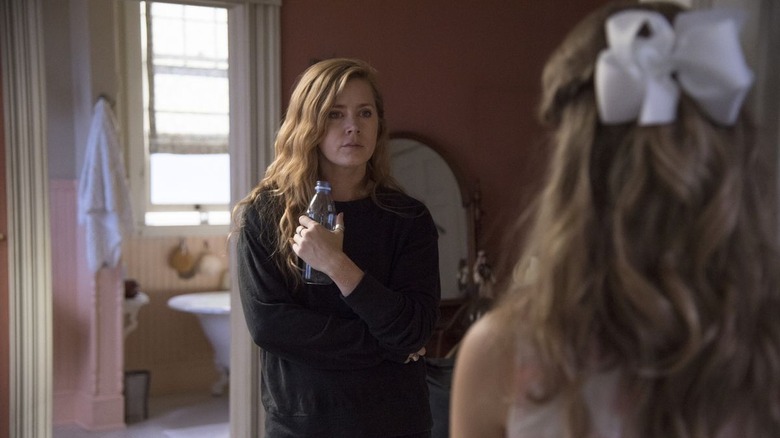The Best Bad Guy Reveals In TV History
TV villains can make or break a show. Fans need to believe the antagonist of a series could threaten its heroes week in and week out. Sometimes this is best achieved by keeping the villain a secret to the audience and the protagonist. In investigative TV, for example, the pursuit of an unknown suspect often not only colors the plot but also drives the character development of the detectives or vengeful civilians on the killer's tail.
But detective potboilers aren't the only types of shows to consistently nail the big bad reveal — many of the best moments from drama, superhero, and serial adventures come when the villain is outed. Existing tensions can escalate even more quickly once the enemy is out in the open; sometimes, on the other hand, the bad guy's reveal changes the direction or meaning of a show entirely. Either way, a baddie's unmasking has the potential to become one of the most memorable moments in television when done correctly — like these epic reveals, which didn't just impact their respective shows and fans, but left a lasting mark on all of TV history. Warning: major spoilers throughout.
Ben Linus has been lying
When "Lost" arrived in 2004, there wasn't much like it on the small screen. It featured an enormous cast and brought over 18 million viewers to ABC – the highest ratings for an offering on the network in almost four years. One thing the show didn't have, however, was an honest-to-goodness villain.
The survivors of downed Oceanic Flight 815 had to weather some pretty singular adversities — there was the smoke monster, of course, and the everlasting conflict between anti-hero Sawyer and, well, everyone — but "Lost" was missing a true big bad. All that changed, however, when actor Michael Emerson showed up as the mysterious Henry Gale in Season 2. Some of the members of the group felt Henry's stories about arriving on the island in a hot-air balloon and losing his wife in the subsequent crash were a bit too neat to be true.
So in the Season 2 episode "Lockdown," the Oceanic survivors go looking for answers. They find a balloon and a grave, but Henry's wife isn't in it — the real Henry is. When the phony Gale is called out for the falsehood, Emerson really shines in the role. He seems to morph into an entirely different person, Ben Linus, in the blink of an eye. This manipulative antagonist would go on to would wreak havoc on the island in the following seasons, finally giving "Lost" a true villain.
When hiding in plain sight, less is Moriarty
The BBC's take on Arthur Conan Doyle's famous literary detective gave Holmes fans one of the all-time greatest bad guy reveals in the episode "The Great Game." When an anonymous criminal concocts a nasty challenge — Sherlock must solve a murderer's riddles to save the lives of hostages hidden across London — the detective sets off to find the perpetrator.
Early in the episode, when Sherlock swings by the morgue, the coroner (who has a hopeless crush on him) attempts to make him jealous by showing off her new beau: the soft-spoken IT guy, Jim. Sherlock brushes off the encounter as insignificant, and so do we.
In the end, Sherlock tries to tempt the killer out of hiding by setting a meeting at a local pool. But when he arrives there to find his partner Watson openly admitting to the killings, Sherlock suspects something is amiss. The detective demands the real criminal show himself, and out saunters ... Jim, the IT guy. He introduces himself as Sherlock's famous arch-nemesis James Moriarty and admits to hiding in plain sight.
After the reveal, the classic foes face off in a game of verbal chess. Actor Andrew Scott brilliantly portrays Moriarty as someone who clearly operates on Sherlock's intellectual level but is even more formidable due to his absolute disregard for right and wrong. It's an amazing poolside showdown, and a reveal worthy of Sherlock's rivalry with a villain whose reputation far preceded him.
The man on the lawn mower
The inaugural season of "True Detective" follows two investigators — played by Matthew McConaughey and Woody Harrelson — on the hunt for a serial killer. Throughout the season, the show's writer and director — Nic Pizzolatto and Cary Fukunaga, respectively — expertly build the expectation of the evil we'll encounter when we meet our villain. The protagonists' escalating run-ins with voodoo, kidnapping cover-ups, and violent meth dealers signal that whatever is waiting at the end, won't be pretty.
At the end of Season 1 Episode 7, audiences are finally clued into the killer's identity and it's ... an almost forgettable groundskeeper from way back in Episode 3. In the hands of a lesser creative team, the moment might've felt like a lazy callback. Not so here. By the time deranged killer Errol Childress appears, casually giving two other police officers directions from his lawn mower, viewers have witnessed a laundry list of evil. The dread of confronting something much worse than what the two leads have previously encountered is as thick as Louisiana's humidity.
As Errol watches the police officers drive off and the creepy music starts to play, we see scars on the lower part of his face consistent with descriptions of a suspect. Revelatory moments like this one really marked the slow-burning 1st season of "True Detective" for greatness: The closing moments of "After You've Gone" dare the audience to keep watching and almost make viewers hope Harrelson and McConaughney stay at home.
Twin Peaks' daddy issues
"Twin Peaks" follows Special Agent Dale Cooper as he investigates the murder of a young woman named Laura Palmer in the small town of Twin Peaks, Washington. Creator and surrealist filmmaker David Lynch's concern for the way evil can hide under the guise of an idyllic life makes the show a unique viewing experience. The show visits some grim and bizarre places during its runtime, but none are darker or more frightening than the harrowing reveal of Laura's killer.
Throughout the show, Cooper and other residents encounter a deviant deity named Killer BOB. BOB's M.O. is evil, plain and simple. However, all of Cooper's run-ins with various spirits and other criminals couldn't prepare the audience for the big "Twin Peaks" reveal: Laura was murdered by her father, respected town lawyer Leland Palmer. The revelation comes in Season 2 Episode 7, when Leland looks at himself in the mirror, sees Killer BOB staring back at him, and then proceeds to murder Maddy, his niece and surrogate sister to Laura. It's horrifying.
It's also the culmination of 14 episodes' worth of groundwork. Everything — from the clues in Laura's case confirming her murderer was a serial killer, to the slow divulging of information about the truth behind the town's supernatural residents — pays off as the audience finally learns the truth: BOB possesses Leland and makes him kill women. The reveal echoes the show's themes that evil truly can take hold anywhere.
Legion's unexpected villain is a 'personal fungus'
"Legion" writer and showrunner Noah Hawley, who also adapted "Fargo" for FX, isn't known for traditional storytelling — so it's no surprise that his bad guy reveal in the Marvel Comics adaptation is truly original. "Legion" follows the mutant life of Professor X's son, David Haller. At the series' start, Haller is unaware of his powers and trapped in a mental institution where he's spent much of his adult life. Life's hard for Haller, but at least he has his (possibly imaginary) best friend Lenny Busker, played by the incomparable Aubrey Plaza, to see him through.
Until he doesn't. Unfortunately for Haller, Lenny's not his friend; she's not even really a person. In reality, she's a psychic parasite hoping to feed off Haller's enormous mind. However, the reveal in Season 1's "Chapter 6" is where writer Hawley chooses to play things very differently. Rather than craft a trail of clues that eventually lead to Haller making the discovery on his own, Hawley has Lenny just flat-out tell her prey that she's his own "walking, talking fungus," growing and feeding off him.
If the scene were performed by anyone less likable than Plaza, it wouldn't reach such devastating heights. Throughout her expository monologue, Plaza flashes through a wide range of emotions in minutes. She moves from seductress to tough lover to confidant to goofy pal, all while proposing a pretty horrible parasitic relationship. The scene is a masterclass in how to subvert expectations.
A yellow suit surprise in The Flash
For much of "The Flash" Season 1, Harrison Wells acts as the kindly, genius founder of S.T.A.R. Labs. He supports Barry Allen's efforts as a superhero and serves as his mentor. Over the course of the season, however, his character begins to act increasingly strange, and Flash and his respective allies suspect something is off. A stinger in Episode 9 shows the audience that Harrison is in possession of Reverse Flash's iconic suit, but the show doesn't confirm the worst until Episode 15.
By that point, most of Team Flash suspect Wells is the yellow speedster, but not everyone is convinced. Unfortunately, Wells' surrogate son Cisco finds out the hard way. After Cisco discovers where Wells hides the suit in the previous episode, Wells confronts him, admitting that he not only had a hand in Barry's mother's death but is actually Eobard Thawne — Flash's all-time big bad. Anyone wondering why Wells might announce his secrets so bluntly gets their answer when Wells follows his monologue by killing Cisco.
A half-season's worth of teasing led up to Thawne's reveal. While pieces were confirmed along the way, the moment where Thawne admits his sins and kills a character his alter ego cared about cements the villain's full arrival and the scope of his malevolence. And it happened in the 1st episode back from the show's mid-season break, giving fans a compelling reason to keep tuning in.
Like father like daughter
The original "Watchmen" graphic novel has an all-time great bad guy reveal, and when he created the "Watchmen" series for HBO, Damon Lindelof chose to keep his surprise villain (pardon the pun) in the family. When viewers first meet Lady Trieu, she's a brilliant, conglomerate-owning, and clone-maintaining scientist with a hidden agenda. However, it's not clear just how dark that agenda is until it's too late.
At first, the show's big bad appears to be an organization called Cyclopes, a white supremacist group out to steal Dr. Manhattan's powers and create the ultimate Übermensch. However, when they attempt their plot in the finale, their leader gets turned into a puddle, and his followers are teleported away to find Trieu waiting with an even larger device designed for the same purpose.
Trieu reveals herself as the real puppet-master and the daughter of Adrian Voight, the surprise villain in the comics. It's brilliant because it not only connects Trieu to a character from the source material, but also connects their murderous motives. In the comics, Adrian blew up Manhattan to trick the world into agreeing to world peace. In Lindelof's series, Trieu murders Dr. Manhattan in an attempt to subjugate the world to her "benevolent" will. The comic and TV series are separated by decades of cultural change, but the latter's villain reveal unites their central questions about wielding immense power over other people in the service of a personal utopian vision.
Agatha all along
Marvel's "WandaVision" kicks off when the Scarlet Witch finds herself married to a newly-risen Vision in an idyllic, literally sitcom-style existence. Viewers watch as Wanda tries to embrace her new life but slowly discovers something's amiss: All isn't what it appears in Wanda's primetime network town, especially when it comes to her neighbors.
Throughout the series, Wanda has kooky and friendly encounters with a neighbor named Agnes, played by a scenery-chewing Kathryn Hahn. Like any sitcom neighbor, she's a bit snoopy, but mostly kind — until the end of Episode 7. While Wanda takes a day to recharge, Agnes looks after her children. Soon, though, Wanda suspects she and her family are in danger and goes to collect her kids.
Agnes tells Wanda the kids are playing in the basement. When Wanda descends the stairs, she finds a witch's lair: Agnes then walks into the room and introduces herself as a fellow witch named Agatha Harkness. As Agnes invades Wanda's mind, the show suddenly cuts to the song "Agatha All Along."
In one catchy tune, Agatha is revealed to have been pulling Wanda's strings throughout the whole series — and worse, she killed Wanda's dog. The number is a great showcase for Hahn's charisma and enormously raises the stakes for the coming series climax by introducing the main antagonist. Who needs subtle reveals? More theme songs, please.
The Man in Black flashes back
When "Westworld" first premiered in 2016, its robo-cowboy worldbuilding and unique storytelling made it must-see TV. As the show confidently swaggered through its time-bending opening season, it delivered twist after twist. One of the most devastating was the finale's bad guy reveal.
In the show's premiere, audiences are introduced to Jimmi Simpson's William and Ed Harris' Man in Black. On first impressions, the two stand in stark contrast to one another. William is a meek but kind first-timer in the theme park, and the Man in Black is a park veteran who revels in doing horrible things to its animatronic hosts. As the series unfolds, it becomes clear that the show's story is set in two distinct timelines. However, since "Westworld" was co-created by Jonathan Nolan, brother and collaborator to the notoriously confusing director Christopher Nolan, it's not always clear exactly which timeline is which.
The show sets the record straight when its protagonist, robotic host Dolores, encounters the Man in Black in the series finale. He reveals that they've met before and that his initial encounter with Dolores helped him find himself. Dolores remembers who he is, calling him William, and the editors intercut his monologue with sequences that show the once-gentle William becoming the evil man he is now. It's tragic that someone so kind could wind up so vile. But in a pivotal moment to the show, his gutting reveal clearly establishes what's present and what's past.
In Broadchurch, trust turns to disgust
To its credit, not many detective shows leave audiences as shaken as "Broadchurch" did, and all of that is due to its villain reveal. In the show, Olivia Colman's intelligent small-town detective, Ellie Miller, partners with a newly transferred detective, David Tennant's Alec Hardy, to investigate the murder of 11-year-old Danny Latimer.
Like most detective shows, in the end, the partners get their man, but by time it's over audiences and protagonists alike will wish he'd never been revealed. The show builds up the devastating discovery by focusing on the impact of trust and distrust. It highlights trust's critical role in relationships by dedicating notable attention to the bonds between its characters — like the supportive relationship between Ellie and her husband Joe.
So in the end, when Hardy discovers Ellie's husband Joe is in possession of Danny's phone, anybody watching prays it's a red herring. But it's not. A flashback reveals that Joe murdered Danny because Danny threatened to expose their pedophilic affair to the town. It's awful on so many levels and adds real bite to the series' focus on trust and secrets.
The murder scene's frantic editing showcases just how fast the threat of exposure escalates things between Joe and his young victim. Once they find out what happened, viewers sit with turning stomachs waiting for Ellie to discover her husband's secret. Only such a powerfully depressing reveal can make the audience hope one of the protagonists never learns the truth.
Death at a wedding on Harper's Island
Like a bestselling beach novel, the CBS limited series "Harper's Island" kicks off when Abby Mills returns to her titular hometown for the wedding of her childhood best friend Henry. Abby hasn't been home in the seven years since her mother was slain by a now-presumed-dead serial killer, John Wakefield.
As soon as Abby gets back, folks start turning up dead. What makes the show so engaging is that its premise is built entirely around the villain reveal, because from the moment the audience is introduced to the large cast of characters, it's apparent most won't make it until the end. The show's most pressing question immediately becomes: Who's killing the wedding guests, and why?
And boy, does it deliver an answer. In the finale, after it's revealed Wakefield is alive and responsible for some of the recent murders, Wakefield attacks Henry's fiancée Trish. But that's not the big twist. Trish flees into the nearby woods, finding Henry. All appears well — for a moment. Henry looks at his bride-to-be, admits he's Wakefield's accomplice, and stabs her. So now viewers have the who, but what about the why?
The answer comes when Henry kidnaps Abby. He explains he's her half-brother, he's obsessed with her, and the murders were a plot to eliminate everyone in the way of them being together. Romeo he isn't, but the surprising reveal of both the villain and his motive makes "Harper's Island" well worth the watch.
A Rudy awakening
Humanizing a murderer is tricky in any medium, but Showtime's "Dexter" managed to do it for eight seasons — and was eventually revived for a ninth. The show's premise, that Dexter is a serial killer who only kills other serial killers, is a strong way to hook an audience. As the show goes on, however, its elaborate twists and turns prove it's more than just its engaging hook.
During Season 1, the show fleshes out Dexter's healthy relationship with his adopted sister, Deb. It also establishes a rivalry between himself and a serial killer known only as the Ice Truck Killer. So things get complicated when the audience discovers that the man courting Deb is actually — gasp — the Ice Truck Killer himself. In a reveal so casual it demands an immediate re-watch, Deb discusses plans for a date with her suitor Rudy. Rudy tells Deb he needs to wrap up some housework before coming over. After he hangs up the phone, the audience gets a look at what that work is — chopping and packing human body parts in his walk-in murder freezer.
It's impeccable dramatic irony: The viewers know the truth about Rudy, but Deb and Dexter remain in the dark — for a long time! For the remainder of the season, the audience watches Dexter and Deb inch closer to the truth (and the danger), and the tension is tangible. "Dexter" is engrossing entertainment, and moments like these cement its place in great TV history.
Don't skip the credits in Sharp Objects
The baddie reveal at the end of HBO's "Sharp Objects" is probably the most audacious on this list, casting the events of the entire show in a new light. "Sharp Objects" is based on Gillian Flynn's novel of the same name — yep, the same author behind "Gone Girl," another story with a shocking villain reveal. HBO's miniseries follows crime reporter Camille Preaker as she returns home to Wind Gap, Missouri.
There, she gets caught up investigating the murders of some local girls. In between sleuthing, she navigates her complex relationships with her mother Adora and her teen half-sister Amma. Ultimately, Camille discovers evidence suggesting Adora killed the girls and sends her own mother to prison. Bleak stuff. But this is a Gillian Flynn story we're talking about: It can always get a lot worse in the most unexpected ways, and moments before the credits roll, it does.
Literally within the show's closing minutes, Camille discovers evidence hidden in Amma's room that suggests she was the killer all along. Amma appears in the doorway, sees Camille, and whispers, "Don't tell Mama." The show hard-cuts to the credits, but anyone trying to catch their breath is acting too soon: A mid-credits scene shows Amma definitively committing each murder, including that of a new friend, Mae, some time later after she and Camille move to St. Louis. It's brilliant and possibly one of the most depressing endings ever committed to the small screen.
